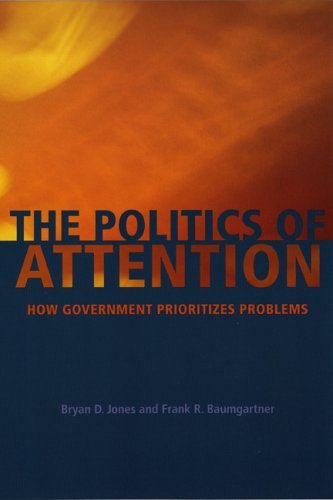 |
- Read published reviews of the book:
- Perspectives
on Politics 4, 3 (September 2006): 598-9, by Paul E. Johnson.
- Political Science
Quarterly 121, 3 (Fall 2006) 515-516, by Scott E. Robinson.
- Social
Forces 85, 3 (December 2006) 1042-43, by John C. Scott.
- Choice
(March 2006), by M. C. Price.
- Political Communication 25 (2008) 330-331, by Kathleen Knight.
- Konan Law Review 47, 3 (2007): 125-166, by
Nishiyama Takayuki (in Japanese).
- Significance 37 (September 2006): 139, by Ya-Hui Kuo.
- Acta Politica 43 (2008): 504-507, by Joost Berkhout
- ThinkProgress.org, February 28, 2011, by Matthew Yglesias.
- Read an article entitled A
Model of Choice for Public Policy in the Journal of Public Administration
Research and Theory 15, 3 (July 2005): 325-51. This article draws
from analysis in The Politics of Attention dealing with federal
budgeting, the incremental model, and our punctuated equilibrium model.
- Download a computer program written by Professor Jim Stimson of the
University of North Carolina that allows users to simulate the friction-based
decision model that we present in the article above and in Chapter 6
of The Politics of Attention. The simulation program allows users
to specify various parameters so that they can see for themselves the
impact of various levels of friction, threshold effects, and other characteristics
of the model.
- View a dynamic gif showing a series of pie
charts illustrating the increased diversity of attention in Congress.
The charts, from the Policy Agendas Project, show the proportion of hearings
in Congress from the 80th Congress (1947-48) to the 105th (1997-98) across
19 different topics of attention. These are the same data used in Baumgartner
and Jones 2000 Journal of Politics article entitled "The Evolution
of Legislative Jurisdictions." They show dramatically how more diverse
congressional attention has grown over the past several decades. (Note:
the gif will show a pie chart for each Congress from the 80th to the 105th
at 2 second intervals, then begin again.)
- See a PowerPoint presentation
of part of the analysis from The Politics of Attention from June
2005 (Presentation at the Centre de Sociologie des Organisations [CNRS-CSO],
Paris.)
|
